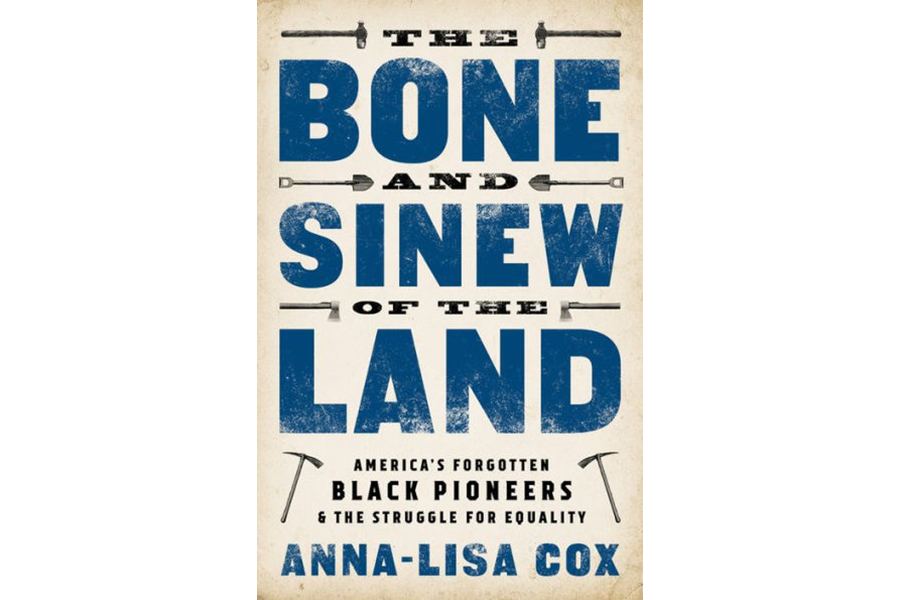'The Bone and Sinew of the Land' restores a lost chapter of US history
Loading...
Before any former slaves were promised “40 acres and a mule,” before anyone uttered the words “Go west, young man,” free black Americans flocked to the nation’s western frontier. There, in the sprawling territory that would become states like Michigan and Illinois, many plowed the land that they themselves owned.
For a time, they had the same rights as their white neighbors. Then came oppression and violence, resistance and resilience, and historical oblivion.
We’ve long forgotten the African-Americans who lived free – at least some of the time – in the Midwest in the decades before the Civil War. Now a new book restores them to their rightful place in history.
In The Bone and Sinew of the Land: America’s Forgotten Black Pioneers & the Struggle for Equality, historian Anna-Lisa Cox digs deep into archives and census data to reveal the hidden lives of the tens of thousands of blacks in the Northwest Territory from 1800 until 1860. (Over the decades, the territory broke up into the states of Michigan, Ohio, Indiana, Wisconsin, and Illinois.)
Historians have known many blacks lived in the territory, but Cox writes that it wasn’t clear before that so many were entrepreneurial farmers who owned dozens, hundreds, and even thousands of acres each.
Her findings reveal “a reality that no one thought existed, of a population that most have considered impossible – a population of successful African American pioneers integrating America’s first frontier,” Cox writes.
Slavery was not allowed in the territory, and all American men who owned at least 50 acres of land could vote regardless of race, at least at first. The equality allowed by law was “astonishing,” Cox writes, and helped the black pioneers see the territory “as a place of fresh hope.”
Indeed, the book takes its title from a letter written by Ohio farmers in a tiny town near the Indiana border to fellow African-Americans in Columbus, urging them to leave the jobs “which prejudice has assigned to you” and “go into the country and become a part of the bone and sinew of the land.”
Unfortunately, we don’t known much about the details of many of their lives. Facing this lack, Cox often chooses to imagine novelistic scenarios about their lives. Her approach is most successful when she stops romanticizing her subjects and instead offers details about the challenges they faced.
For example, Cox reveals that farmers had to store their plows indoors. Otherwise, “creatures from bears to squirrels would gnaw on the handles soaked with their sweat and salt.” Readers also learn about the elaborate process to prepare wool and the fact that it typically took 20 years for “frontier farmers to clear their land so they could plow with horses instead of oxen” – two decades of “felling trees, chopping roots, pulling rocks.”
While these pioneers were successful enough to start schools and churches, the Northwest Territory was far from paradise. Whites were also flooding into the Great West, and many didn’t want to share the bounty with blacks.
The oppression faced by these black pioneers is well chronicled and devastatingly vivid in “Bone and Sinew.” Over time, the rights of African-Americans dwindled and hatred rose.
So-called Black Laws destroyed the hopes of resettling former slaves by requiring them to prove they were free and to find two frontiersmen to deposit a bond of a stunning $500. And whites revoked voting rights for black men as the Northwest Territory began to split up into states.
Yes, Cox notes, “there was always a dissenting voice arguing for equality.” That’s heartening. But, as she sharply observes, this fact exposes another truth: It means that there was debate, and “whites were very thoughtfully and deliberately withdrawing the right of citizenship from African-Americans.”
Racist whites found other ways to oppress free black people through indentured servitude – slavery in all but name. Some blacks found horrific employment in “salt springs,” where they mined salt amid “whippings, fire, smoke and a muddy, ever-deepening pit.” White mobs also attacked the schools, churches, and newspaper offices of black people.
Today, many of the legacies of the black pioneers are scattered. There’s an African-American church in Indiana that persevered despite being torched again. And in Ohio, a “mansion of brick and limestone as grand as any plantation in the South” still stands. It was once owned by members of a black family who started a school for both genders and all races and “were active conductors on the Underground Railroad.”
There’s another legacy: all the 19th-century Americans who were fed because these pioneers dared to plow and plant and persevere.
Randy Dotinga contributes regularly to The Christian Science Monitor.








